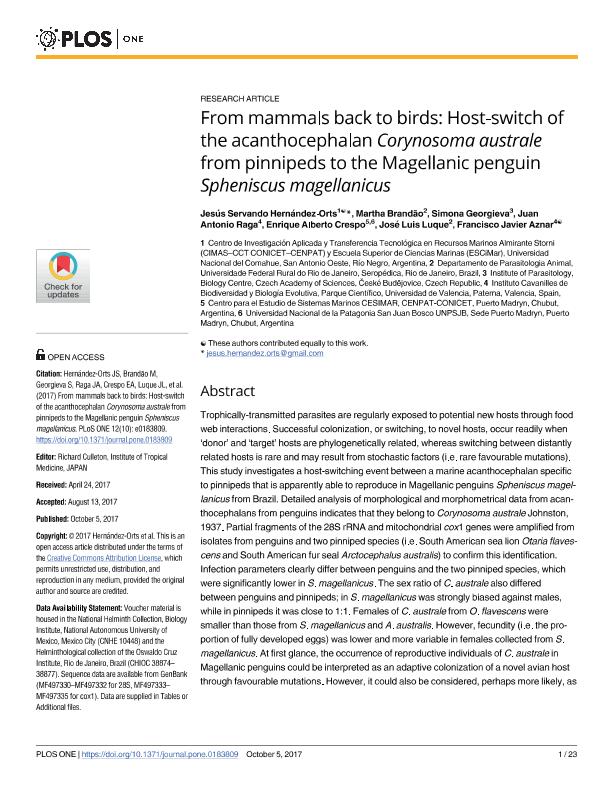Artículo
From mammals back to birds: Host-switch of the acanthocephalan Corynosoma australe from pinnipeds to the Magellanic penguin Spheniscus magellanicus
Hernández Orts, Jesús Servando ; Brandão, Martha; Georgieva, Simona; Raga, Juan Antonio; Crespo, Enrique Alberto
; Brandão, Martha; Georgieva, Simona; Raga, Juan Antonio; Crespo, Enrique Alberto ; Luque, José Luis; Aznar Avendaño, Francisco Javier
; Luque, José Luis; Aznar Avendaño, Francisco Javier
 ; Brandão, Martha; Georgieva, Simona; Raga, Juan Antonio; Crespo, Enrique Alberto
; Brandão, Martha; Georgieva, Simona; Raga, Juan Antonio; Crespo, Enrique Alberto ; Luque, José Luis; Aznar Avendaño, Francisco Javier
; Luque, José Luis; Aznar Avendaño, Francisco Javier
Fecha de publicación:
10/2017
Editorial:
Public Library of Science
Revista:
Plos One
ISSN:
1932-6203
Idioma:
Inglés
Tipo de recurso:
Artículo publicado
Clasificación temática:
Resumen
Trophically-transmitted parasites are regularly exposed to potential new hosts through food web interactions. Successful colonization, or switching, to novel hosts, occur readily when ?donor? and ?target? hosts are phylogenetically related, whereas switching between distantly related hosts is rare and may result from stochastic factors (i.e. rare favourable mutations). This study investigates a host-switching event between a marine acanthocephalan specific to pinnipeds that is apparently able to reproduce in Magellanic penguins Spheniscus magellanicus from Brazil. Detailed analysis of morphological and morphometrical data from acanthocephalans from penguins indicates that they belong to Corynosoma australe Johnston, 1937. Partial fragments of the 28S rRNA and mitochondrial cox1 genes were amplified from isolates from penguins and two pinniped species (i.e. South American sea lion Otaria flavescens and South American fur seal Arctocephalus australis) to confirm this identification. Infection parameters clearly differ between penguins and the two pinniped species, which were significantly lower in S. magellanicus. The sex ratio of C. australe also differed between penguins and pinnipeds; in S. magellanicus was strongly biased against males, while in pinnipeds it was close to 1:1. Females of C. australe from O. flavescens were smaller than those from S. magellanicus and A. australis. However, fecundity (i.e. the proportion of fully developed eggs) was lower and more variable in females collected from S. magellanicus. At first glance, the occurrence of reproductive individuals of C. australe in Magellanic penguins could be interpreted as an adaptive colonization of a novel avian host through favourable mutations. However, it could also be considered, perhaps more likely, as an example of ecological fitting through the use of a plesimorphic (host) resource, since the ancestors of Corynosoma infected aquatic birds.
Palabras clave:
Magellanic Penguin
,
Pinnipeds
Archivos asociados
Licencia
Identificadores
Colecciones
Articulos(CESIMAR)
Articulos de CENTRO PARA EL ESTUDIO DE SISTEMAS MARINOS
Articulos de CENTRO PARA EL ESTUDIO DE SISTEMAS MARINOS
Citación
Hernández Orts, Jesús Servando; Brandão, Martha; Georgieva, Simona; Raga, Juan Antonio; Crespo, Enrique Alberto; et al.; From mammals back to birds: Host-switch of the acanthocephalan Corynosoma australe from pinnipeds to the Magellanic penguin Spheniscus magellanicus; Public Library of Science; Plos One; 12; 10; 10-2017; 1-23
Compartir
Altmétricas



